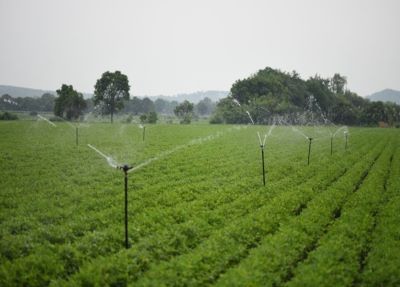Context-
As India approaches its centennial year of independence in 2047, the vision of becoming a developed nation necessitates a substantial increase in per capita Gross National Income (GNI) approximately six times its current level. Achieving this ambitious goal will require transformative changes across various sectors, with agriculture playing a pivotal role.
Current State of Indian Agriculture
Sustainable Practices and Technology advancements
To ensure long-term productivity and environmental health, Indian agriculture must adopt sustainable practices. Key initiatives include:
● Precision Farming: Utilizes technology to optimize field-level management regarding crop farming.
● Genetically Modified Crops: Aims to enhance crop yields and resistance to pests.
● Advanced Irrigation Techniques: Systems like drip and sprinkler irrigation are improving water-use efficiency.
One significant initiative is the Pradhan Mantri Krishi Sinchayee Yojana (PMKSY), which has already covered 78 lakh hectares. With a substantial allocation of ₹93,068 crore for 2021-26, PMKSY underscores the government’s commitment to enhancing water management through micro-irrigation.
Risk Management and Market Access
India's agricultural sector also faces significant risks and market challenges:
● Pradhan Mantri Fasal Bima Yojana (PMFBY): Launched in 2016, this scheme provides financial support for crop losses. With 49.5 crore farmers enrolled and claims exceeding ₹1.45 lakh crore, PMFBY is crucial for agricultural risk management.
● Electronic National Agriculture Market (eNAM): Established in 2016, eNAM integrates existing markets through an electronic platform. By September 2023, 1,361 mandis were integrated, benefiting 1.76 million farmers and recording trade worth ₹2.88 lakh crore. This platform enhances market access and ensures better price realization.
Challenges in Indian Agriculture
Disparity Between Workforce and GDP Contribution
Despite agriculture engaging nearly 46% of India’s workforce, its contribution to the GDP is about 18%. This imbalance is concerning as current growth trends suggest a worsening disparity:
● GDP Growth Trends: Overall GDP has grown at 6.1% annually since 1991-92, while agricultural GDP has lagged at 3.3%. Under the Narendra Modi administration, overall GDP growth was 5.9%, with agriculture growing at 3.6%. This rate is insufficient given the sector's importance to India’s socio-economic fabric.
● Projected Decline: By 2047, agriculture’s share in GDP might shrink to 7%-8%, yet it could still employ over 30% of the workforce if no significant structural changes are made.
Impact of Population Growth
India’s population is projected to reach 1.5 billion by 2030 and 1.59 billion by 2040. Meeting the food requirements of this growing population is a major challenge:
● Food Demand Growth: With an estimated expenditure elasticity of food at 0.45, the demand for food is expected to grow by approximately 2.85% annually, considering a population growth rate of 0.85%.
● Commodity Demand Variations: Post-2023, the demand for different food commodities will vary, with meat demand growing by 5.42% and rice demand by only 0.34%.
Strategic Initiatives for Agricultural Growth
Financial and Technological Support
Several initiatives have been launched to enhance farmer prosperity and promote sustainable agricultural growth:
● Pradhan Mantri Kisan Samman Nidhi (PM-KISAN): Initiated in 2019, this scheme provides ₹6,000 annually to farmers in three installments. It has benefited over 11.8 crore farmers, offering essential financial support.
● Soil Health Card (SHC) Scheme: This initiative aims to optimize soil nutrient use, thus improving agricultural productivity. Over 23 crore SHCs have been distributed, providing farmers with vital insights into soil health and nutrient management.
● International Year of Millets 2023: This initiative promotes nutritious coarse grains domestically and internationally.
Infrastructure Development
● Agriculture Infrastructure Fund: With a ₹1 lakh crore financing facility, this fund supports the development and modernization of post-harvest management infrastructure. Over three years, 38,326 projects have been sanctioned, mobilizing ₹30,030 crore. These projects have created employment for more than 5.8 lakh individuals and improved farmer incomes by 20%-25% through better price realization.
● SVAMITVA Initiative: The Survey of Villages and Mapping with Improvised Technology in Village Areas (SVAMITVA) program aims to ensure transparent property ownership in rural areas. As of September 2023, over 1.6 crore property cards have been generated, enhancing land security and facilitating credit access for farmers.
Future Planning and Projections
Anticipated Demand and Production
Strategic planning for Indian agriculture leading up to 2047 focuses on several critical areas:
● Future Food Demand: Projections suggest that the total demand for food grains in 2047-48 will range from 402 million tonnes to 437 million tonnes. Under the Business-As-Usual (BAU) scenario, production is expected to exceed demand by 10%-13%.
● Investment Needs: To meet this demand sustainably, substantial investments in agricultural research, infrastructure, and policy support are essential.
Budgetary and Policy Support
● Budget for 2024-25: The allocation of ₹20 lakh crore for targeted agricultural credit and the launch of the Agriculture Accelerator Fund highlights the government’s proactive approach to fostering agricultural innovation and growth.
Conclusion
The path to 2047 presents both significant challenges and opportunities for Indian agriculture. To ensure a prosperous future, India must embrace sustainable practices, leverage technological innovations, and implement strategic initiatives effectively. By addressing current disparities, investing in infrastructure, and preparing for future demands, India can enhance farmer incomes, meet the food needs of its growing population, and achieve inclusive and sustainable development in agriculture.
|
Probable Questions for UPSC Mains Exam-
|
Source- The Hindu







